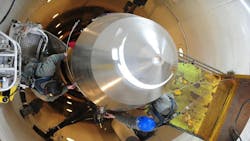A Boeing-Northrop team may be the only way to fix the Air Force's flawed ICBM competition
WASHINGTON – Intercontinental ballistic missiles (ICBMs) housed in hardened underground silos are a vital part of the nation’s nuclear weapons deterrent. Forbes reports. Continue reading original article
The Military & Aerospace Electronics take:
8 Aug. 2019 -- ICBMs are cheaper to maintain and more responsive in a crisis than the submarine-launched missiles and bombers that comprise the rest of the strategic force. At least, that’s what the Pentagon’s most recent nuclear posture review found.
However, the 400 Minuteman III ICBMs in the current force are 50 years old, and not expected to be reliable beyond 2030. The Air Force has done an admirable job of keeping the missiles in a high state of readiness, but they need replacements. With that goal in mind, the service launched a program called the Ground Based Strategic Deterrent (GBSD) to develop a successor.
In 2017, it picked Boeing and Northrop Grumman to compete for the contract to develop GBSD. They were the logical candidates, because the two companies share virtually all of the nation’s recent experience with designing, developing and building ICBMs. Under the terms of the competition, the companies had three years to mature technologies to a point where their rival offerings could be compared.
Related: The evolving world of radiation-hardened electronics
Related: Boeing to upgrade missile guidance systems on Minuteman III land-based nuclear rockets
John Keller, chief editor
Military & Aerospace Electronics
